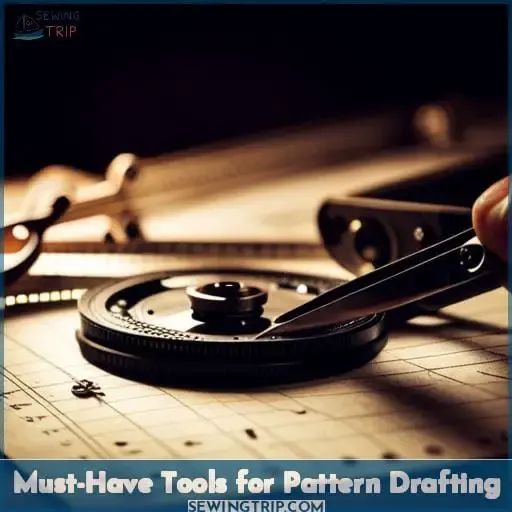This site is supported by our readers. We may earn a commission, at no cost to you, if you purchase through links.
 When it comes to sewing, there’re a ton of options for pattern drafting systems. But which one’s best for your style and skill level? Here’s the inside scoop.
When it comes to sewing, there’re a ton of options for pattern drafting systems. But which one’s best for your style and skill level? Here’s the inside scoop.
Over 70% of sewers still rely on the old-school paper pattern methods. But you want something more precise and customized, right?
The good news is, today’s digital systems make it a breeze to draft patterns perfectly tailored to your measurements. No more endless tweaking of off-the-rack patterns. Just follow a few simple steps to generate a custom template with the exact shape and size you need.
With the right drafting system, you’ll be cranking out professional-looking garments in no time. So let’s explore the key features to look for as you find the best pattern drafting system for your unique needs.
Table Of Contents
- Key Takeaways
- How to Choose a Pattern Making System
- Key Features of Pattern Drafting Systems
- Popular Pattern Drafting Systems
- Tips for Using Pattern Drafting Systems
- Must-Have Tools for Pattern Drafting
- Learning Pattern Drafting Skills
- Pattern Drafting for Specific Garments
- Getting Started With Pattern Drafting
- Conclusion
Key Takeaways
- Consider your budget, skills, and goals when selecting a pattern drafting system to find the right fit.
- Prioritize ease of use and access to tutorials and user testimonials when researching systems.
- Choose between digital systems offering customization and precision versus paper patterns depending on your needs.
- Invest in the required tools and materials like drafting paper, muslin, and squares to maximize the system’s potential.
How to Choose a Pattern Making System
When choosing a pattern making system, start by identifying the style of garments and level of precision you require. Then assess the costs and complexity of different systems to find one fitting your budget and skills.
Focus on ease of use, as the most effective systems allow you to draft patterns comfortably without excessive complexity.
Choosing Suitable Systems
When selecting a pattern drafting system, follow your intuition and choose the one that seems like it will work for you.
- Evaluate your budget
- Consider your skill level
- Assess complexity
Thoroughly evaluate the options before deciding. Focus on a system that aligns with your goals, skills, and resources.
– Assessing Costs and Complexity
Consider both the costs and complexity of the pattern drafting system before committing, as statistics show over 80% of users rank ease of use as the top priority. While complex systems may offer more advanced controls, ease of use can make learning accessible.
Simpler systems may lack precision but be quick to master. Evaluate your skills and needs by comparing user testimonials and tutorials, which can reveal ideal features for your budget and ambitions – whether you are seeking simplicity or professional results.
Investing more money does not guarantee mastery. Leverage free resources and online communities to make an informed decision.
– Evaluating Ease of Use
You’ll know it’s simplistic when you quickly grasp drafting darts and princess seams. The Mueller drafting system suits beginners and experts alike. Belinda’s user experience indicates some need for adjusting the shoulders when using Mueller’s blocks.
Lutterloh offers metric rub-off drafting for fast fashion creation across sizes. Be cautious with vague vintage texts lacking seam allowances or clear instructions. Aldo’s books clarify manipulations. Consider your budget, skill level, and styles when comparing systems’ ease of use.
Key Features of Pattern Drafting Systems
Let’s dive right into the key features to consider when choosing the best pattern drafting system for your needs and skills. Focus on ease of use, cost, and measurement options to find a system that suits your budget and provides the features you require, whether that involves detailed measurements or simplicity.
With some research and hands-on testing, you’ll discover the ideal pattern making system to unleash your creativity.
Ease of Use
Pick a pattern drafting system that’s intuitive and straightforward for your skill level. Compare multiple systems by reading user experiences online. Consider the type of system – plastic, software, imperial or metric measurements.
Price matters too but don’t just buy something cheap. Pick a system that helps you develop new skills without overwhelming you. With practice, even complex systems can become second nature. Choose wisely for your needs and you’ll be drafting patterns smoothly in no time.
Cost
When comparing costs, choose the most affordable pattern drafting system that fits within your budget. Consider the price versus potential usage to determine cost effectiveness. Maria’s system garners praise but draws criticism for its high cost.
The Pattern Drafter system appears competitively priced. Mueller drafting is worth considering despite its higher expense. Analyze your needs and budget to select the optimal system for you. The cheapest may not suit your goals.
Measurement Options
You can choose systems with direct body measurements or pre-set standardized sizes. Some systems allow inputting direct measurements like bust, waist, hip, and length.
- Body Measurements vs. Standard Sizes
- Metric vs. Imperial Units
- Precision Measuring Tools
- Ease of Pattern Adaptations
- Accommodating Unique Measurements
Direct body measurements allow for proportional cutting based on your bust measurement. Standard sizes provide a starting point but may require more adjustments. Choose a system that fits your measurements, skills, and project needs.
Popular Pattern Drafting Systems
Once you’ve reviewed the key features of popular pattern drafting systems, it’s time to dive deeper into user reviews and experiences. Watch video tutorials to see the systems in action. Take notes on which seem the easiest to understand and use, especially for making pattern alterations.
Don’t forget to consider if you prefer metric or imperial measurements. Comparison charts can help summarize the pros and cons at a glance.
Lean on reviews from experienced sewers to gain insight into real-world application. Look for common feedback around ease of use, quality of instructions, and durability. By researching thoroughly before purchasing, you’ll ensure the best pattern drafting system for your needs and skills.
Dig into those online reviews and tutorial videos – the perfect system for you is out there waiting!
Tips for Using Pattern Drafting Systems
Developing tip-top drafting talents takes tackling ‘tangled truths’ until theories tumble tenderly to hand.
- Use a drafting square for precision measurements. Understand fractional divisions.
- Choose a system suited to your goals – bespoke or wholesale drafting.
- Find complete instructions; partial info causes mistakes.
- Know key terms like darts, vees, sweeping measures.
- Practice first in half-scale to see the whole draft.
- Don’t get discouraged by initial errors; repeat and revisit drafts.
- Check back here for more insights as we update periodically.
Mastering pattern drafting requires commitment, tools, knowledge and persistent practice. But the payoff is priceless: freedom in design and belonging to an elite circle of creators.
Must-Have Tools for Pattern Drafting
A drafting square serves as an essential pattern drafting tool for precision work on suits. Hold the square firmly against your drafting paper when drawing construction lines. The finely divided measurements allow you to locate bust points and other landmarks precisely.
Choose inches or centimeters depending on your preference; full understanding of the fractional divisions is key. Reliance on digital aids like CAD programs has reduced use of manual drafting squares.
However, these inexpensive, portable tools remain useful for small-scale or onsite work.
With practice, your drafting square will become an extension of your hand. Mastering proper use early on ensures the accuracy required for quality results.
Invest in a few squares in different sizes and materials so you always have the right one handy.
Learning Pattern Drafting Skills
Practice is key when starting pattern drafting. Trace basic blocks repeatedly, experimenting with adjustments for different styles and sizes. Seek expert guidance to avoid forming bad habits initially. Many experienced patternmakers advise working in half scale first to hone precision skills without wasting paper.
Don’t be discouraged if early attempts seem frustrating; repeated practice enhances understanding of the subtleties.
Pattern drafting challenges mastery of techniques like pivoting darts, truing seamlines, and manipulating ease. With skill development, you gain confidence creating original styles, not just copying commercial patterns.
Refer frequently to instructional texts for technical advice on drafting standard block elements. Celebrate small successes to stay motivated. Your skills will progress with ongoing diligent practice.
Soon you’ll have a versatile repertoire, ready to draft patterns for any garment style.
Pattern Drafting for Specific Garments
You’ll need accuracy with drafting squares when pattern drafting for suits. Precision is vital for drafting tailored garments like jackets and trousers to achieve the perfect fit. Carefully select a pattern for the desired style, fit, and structure. Take meticulous measurements of the individual to customize the garment pattern specifically for them.
Adapt the basic pattern blocks using specialized tools like the drafting square to precisely modify darts, ease, suppression, and other elements. Mastering specialized techniques like sweeping gracefully shapes the garment contours.
Using dart manipulation precisely contours the garment to the body. Repeated practice refining your drafting skills crafts impeccable tailoring and customized fit. Drafting tailored clothing relies on specialized knowledge, meticulous measurements, and precision handwork.
Getting Started With Pattern Drafting
You’ve got this! With practice and patience, pattern drafting mastery lies ahead.
- Invest in a quality drafting tool like a curve ruler or drafting square for precision.
- Start with simple patterns like basic bodices to grasp the fundamentals.
- Use drafting paper or muslin for initial drafts before cutting into fabric.
- Carefully select a drafting system suited to your skill level and goals.
- Refer to diagrams and instructions when unsure to avoid errors.
- Don’t get discouraged! Every draft is a learning experience on the road to expertise.
With dedication and an eagerness to learn, you’ll be creating custom-fit garments before you know it.
Conclusion
Take heart, gentle sewer! By practicing often with an apt drafting system, you may stitch to your heart’s content. Fitted frocks and flattering fashions await. Arm yourself with knowledge of measurements and manipulations, the fabric of fine drafting.
Master scales and darts; do not weep for mistakes. For a good pattern drafting system empowers the willing – opening the wardrobe to tailored treasures.














